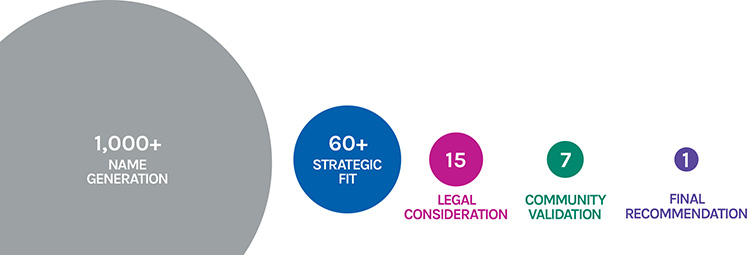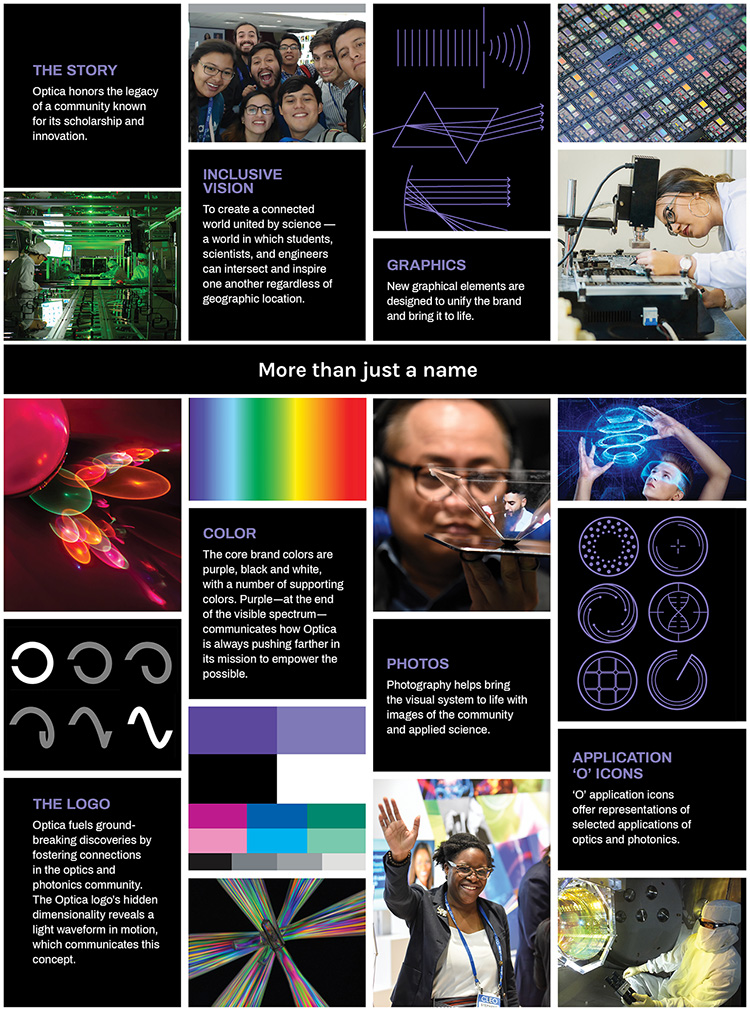 Since the society’s founding in 1916, optics and photonics have seen enormous change and growth. [View credits]
Since the society’s founding in 1916, optics and photonics have seen enormous change and growth. [View credits]
“If names be not correct,” wrote Confucius 25 centuries ago in the Analects, “language is not in accordance with the truth of things.” And the ancient sage’s wisdom has an unspoken corollary: When the truth of things changes, sometimes a name, too, needs to evolve.
As of 20 September 2021, the organization born 105 years ago as the Optical Society of America (OSA) takes on a new name: Optica.
As of 20 September 2021, the organization born 105 years ago as the Optical Society of America (OSA) takes on a new name: Optica. The new name reflects profound changes—in the organization, in optical science and technology, in the world at large—since the society’s founding a century ago. Along with an accompanying, revitalized visual identity, the new name aims to advance the society’s mission of serving its scientific community in the next hundred years—when optics and photonics seem destined to play a leading role in solving some of the world’s toughest problems.
Decades in the making
In a number of its manifestations—websites, email addresses, the sign at corporate headquarters and more—the transformation from OSA to Optica may seem to have happened virtually overnight. Yet the change was anything but sudden, according to the society’s 2018 President, Ian Walmsley, who worked with a group of other leaders and volunteers on the transition. “This conversation,” he says, “started 30 years ago.”
The society, Walmsley notes, first eyed a significant change back in 1989. At that time, OSA’s strategic-planning committee—then called the Society Objectives and Policy (SOAP) Committee—recommended that the organization adopt a new name: The Optics and Photonics Society.
The proposed new handle sprang in part, according to a February 1990 OPN article, from a need “to respond to the large predicted growth of the photonics segment of the OSA membership.” Since the society’s 1916 founding, the field had seen the invention and spectacular advance of the laser; the rise of nonlinear optics and holography; optical tweezers and laser cooling; fiber optic communications and sensing. It seemed time to give a nod, in the organization’s name, to the burgeoning photonics side of the business.
But the SOAP Committee also cited, as a “second item of consideration,” the society’s increasingly international scope. By 1989, more than 21% of OSA members lived outside North America—“a percentage,” the committee wrote, “that can be expected to increase as research activities in optics and photonics expand in Europe, Asia and Australia.”
Walmsley says the OSA Board “fully approved” of the name change, and voted to initiate the process at its meeting on 21 October 1989. But in May 1990, in the face of opposition by some member communities, the Board dropped the adoption of the proposed name change. (A vestige of the process does remain visible, though, in the publication you’re reading—at the end of 1989, the name of the society’s monthly magazine, Optics News, was updated to Optics & Photonics News.)
Changing science, changing world
While a name change for OSA was taken off the table at that time, the underlying issues didn’t disappear. The explosion of optics and photonics as a discipline continued, with new ferment in metamaterials, ultrafast laser science, quantum technology, 5G networks and a raft of other areas. And the society’s membership grew ever more global, in sync with the increasing worldwide scope of the science itself.
 FAQs on a name change
FAQs on a name change
Optica has assembled a list of frequently asked questions regarding the brand transition. A sample is below; the full list can be found at optica.org/faqs.
Why didn’t changing the name to “The Optical Society (OSA)” work?
The change was a step in the right direction. Still, as our leadership envisioned the organization’s future and provided recommendations on how we might best continue to evolve, they found that “The Optical Society” name remained an obstacle. The relatively slight modification to the original Optical Society of America title did not reflect the significant changes the society has experienced, nor did it provide sufficient room for its continued growth.
Will we risk losing 100 years of goodwill and reputation with this change?
We value our rich history and will continue to do so. Our new name and tagline acknowledge that history, our values, and who we have become. It also provides the flexibility to embrace change as our membership and field evolve.
Optica is the name of our premier journal—won’t people be confused?
The Optica journal is highly successful and is strongly identified with our organization. This will support our work to rebrand the society as a whole. That being said, we have developed strategies to communicate the difference between the publication and the organization. We are confident we will be effective with these efforts.
As a nod toward the latter reality, in 2008, the society decided that, while it would not change its legal name, it would begin doing business as The Optical Society—while retaining its traditional acronym, OSA. However, Walmsley says, “despite lots of effort, that didn’t prove to be a bold enough change to reflect what OSA had become.”
Or, it might be added, to reflect how light science and technology itself has changed. It’s estimated that annual worldwide optics and photonics revenues have grown some 24% in the past five years, amounting to half a trillion U.S. dollars today. And, as an reflection of that explosive growth, the society’s products and services—from meetings to publications to grants and other support—now reach an estimated 432,000 persons across 93% of the globe.
“Here we are, 30 years later, discussing the same issue”—a change in the society’s name—“except the global context is completely different today,” Walmsley says. “We didn’t have the right solution before; we do have it today. It’s the right time for this change.”
Moving forward
In 2016, OSA marked its centennial year. It was, of course, a time to celebrate the organization’s rich history, and it saw the adoption of a new “OSA 100” logo for the society. Yet the centennial also prompted considerable reflection on the next 100 years, for both the society and the science and community it serves. And the OSA Board decided it was time to come to grips with the long-standing issue of the society’s name.
The process began in earnest the very next year—and, according to the society’s 2017 President, Eric Mazur, “we took our time with this important decision.” Among the early steps, he says, were “hundreds of conversations” with a cross-section of members from various countries and career stages. These discussions, says Mazur, reinforced concerns about the limitations of the society’s existing name. To move in a deliberate way to a new one, the organization enlisted the help of a number of experts in brand strategy implementation.
The subsequent effort, which unfolded across two years, allowed the society’s leadership to recommit to, and clarify, its vision and mission: to be the leading worldwide forum for light science and technology. As the exploration continued, four guiding principles of the society emerged: ensuring unsurpassed quality; being at the forefront of technological change; being inclusively global; and being a champion of the field. These principles served as “pillars” helping to shape the effort to update and extend the organization’s brand.
 A board of society volunteers began with a list of more than a thousand possible names—and, through extensive research and discussion, reduced the list to seven distinct names that were put out to members of the optics and photonics community for extensive testing, validation and feedback. One clear winner emerged—Optica.
A board of society volunteers began with a list of more than a thousand possible names—and, through extensive research and discussion, reduced the list to seven distinct names that were put out to members of the optics and photonics community for extensive testing, validation and feedback. One clear winner emerged—Optica.
Narrowing down
To get to a new name, Mazur says, a brand subcommittee of the society’s Board began with a list of more than a thousand possible names—and, through extensive research and consultation with other volunteers, reduced the list to more than 60 “that were a strategic fit and met our established criteria.” Those 60 names next had to navigate a labyrinth of international trademark law, available online domain names, and a variety of other competitive considerations—all of which pared the list down to 15 viable options.
From that list of 15, seven distinct names emerged that were put out to members of the optics and photonics community for extensive testing, validation and feedback. “There was one clear winner—Optica,” says Mazur.
The change in the organization’s name is only part of a broader change in its logos, visuals and more that members and the public will see over the next few months.
The change in the organization’s name is only part of a broader change in its logos, visuals and more that members and the public will see over the next few months. Perhaps most important, Optica’s name will frequently appear accompanied by a tagline—Advancing Optics and Photonics Worldwide—designed to encapsulate the society’s role serving an evolving science.
And work on the new name proceeded in parallel with dramatic changes in colors, graphics, line art and other visual items. These visual changes should help to pull together the society’s many offerings—publications (through the renamed Optica Publishing Group), industry support, meetings, outreach, charitable activities (through the Optica Foundation), public affairs and more—in a unified way, and in an intriguing and brisk new look. (See “More than just a name,” below.)
 COVID complications
COVID complications
As 2020 dawned, OSA staff and volunteers were looking forward to the launch of the society’s new name—Optica—and the extraordinary visual style of the revitalized brand.
Then came COVID-19, which forced postponement of the planned launch. Part of that delay acknowledged an unpromising media environment; in the pandemic’s early days, news outlets were so overwhelmed with COVID stories that any attempt to communicate the name change of a nonprofit science organization would have been lost in the noise.
Yet the decision was also practical. The society, like others, was attempting to adapt to the new environment and meet a wide range of unexpected demands that it hadn’t faced before. Particularly pressing was the vital need to transition from in-person to virtual conferences and events, and creating new electronic channels for networking and learning—all steps, interestingly, that were enabled by spectacular advances in light science and technology. Volunteer and staff bandwidth was thin, and it made sense to look to a later date.
Ian Walmsley notes that, if anything, the pandemic underscores the rationale for the name change. “Thinking and acting globally is crucial to the success of our field,” he says, adding that the pandemic demonstrates the crucial role that the society has in “keeping our research and industry communities connected and working together.”
The pandemic has not gone away, of course. But with the initial shock of 2020 over, the society opted to launch in September 2021. And Jens Biegert suggests that now may well be good timing for the switch.
“We’re in this pandemic, and we hope to all get out of it,” he says. “This gives a positive thing, a change to look forward to … It’s important not to be stagnant and complacent. It’s an important signal, and probably not bad timing to use this as a positive push.”
As with so many other things, the COVID-19 pandemic significantly complicated the transition to the society’s new name (see “COVID complications, right). But as of 20 September 2021, the long run-up to the change is complete—and Mazur is more than satisfied with the result. “I’m really excited to see how [this change] will accelerate the growth of our increasingly diverse and inclusive community,” he says.
“Optica empowers the potential of light to improve the world,” Mazur says. “That simple but powerful line captures the essence of what our society is here to achieve.”
Society and journal
As the society transitions to the new name and brand, the effort could benefit from the name recognition and positive reputation of one of its more visible publications: the high-impact journal called Optica. The people OPN talked with viewed that association as a strength—and an opportunity.
A particularly interesting perspective comes from Optica Fellow Prem Kumar (Northwestern University, USA), who took over as the journal Optica’s editor-in-chief in January 2020. “Usually, societies give value to their publications,” Kumar says. “But Optica has been very successful as a journal whose charter is to publish the best work of its authors … and that can give value back to the society. We’ve come full circle in a way.”
“It will require a certain reorientation in our minds, as to how we think about it,” Kumar acknowledges. “But Optica is a wonderful name … As scientists and engineers, we are going to have to come up with the solutions needed to attack the biggest problems the world faces. Having a name that reflects the field, as opposed to a geographical association, is a good thing; it contributes to bringing the world together.”
Toward inclusivity
Antigone Marino (National Research Council, Italy), an Optica Ambassador and a board member of the Optica Foundation, sounded a similar note. “The society took an amazing step in changing its name,” she says. “Optica is a name for everyone—for Europeans, for Asians, for Africans, for Australians, for South Americans, for North Americans, even for the two poles, I think!”
Optica Fellow Jens Biegert (ICFO, Spain), who chairs the society’s Board of Meetings, also sees the new brand name as a positive step. “I was a grad student in the United States, so I grew up with ‘the Optical Society of America’—it has a special meaning for me,” he says. “But I’m also a European, and science is global … This [the change to Optica] was an important thing to do.”
A modern sensibility
In addition to recognizing the worldwide scope of optics and photonics, a number of people OPN talked with saw advantages in other spheres, where the characteristics of the brisk name Optica could project a renewed vitality. Optica Fellow Amy Eskilson (Inrad Optics, USA) says that “from an industry perspective, the freshness, the modern sound, is going to be appreciated … We’re in this world of Apple, Google, Amazon—there’s just a modernity around a single word.”
Eskilson herself is a veteran of a similar brand change. Years ago, her company, then called Photonic Products Group, made the transition to Inrad Optics, a short, memorable phrase that built on the reputation of an earlier company name. “For us it was essential, to create a memory” of who the company is, she says. “So the change to Optica resonated with me. This change is going to provide more than a new name; it’s an opportunity for a new culture, a modernization.”
Katherine Calabro (Synopsys, USA) also thinks the change will be well received by industry. “It’s not like organizations have never changed their names, or their branding,” she points out. “Industry is used to those kinds of disruptions … If anything, industrial partners will view this as a way of trying to modernize and to adapt to a changing marketplace.” Calabro, who will take over next year as chair of the Optica Membership Engagement and Development (MED) Council, believes that the change in the society’s name offers some prime opportunities for growth and diversification of membership. “We are going to be significantly more attractive to newer markets,” she says.
Communicating the change
Nobel laureate Donna Strickland, the society’s 2013 President, notes that everyone at the organization “recognizes the magnitude of this change” and that how it is introduced to the community is crucial. According to Strickland, key players in communicating the change will be a core group of volunteer leaders who “will help us manage a smooth transition.”
Nobel laureate Donna Strickland, the society’s 2013 President, notes that everyone at the organization “recognizes the magnitude of this change.”
In addition, the efforts will include extensive communications across a range of media channels, active outreach, support and custom marketing materials for student chapters and local sections, and more. Strickland also cites a new online photography exhibit, Faces of Optica (featured on the cover and in the infographic on p. 14)—an evolving collection featuring striking photos and quotations that highlight the society’s diverse membership.
To be sure, the change will take time to diffuse through the community. “I’m a nostalgic person,” says Antigone Marino. “I will miss our historical logo, and probably I will say ‘The Optical Society’ for a long time. But societies have to evolve, as the world is evolving … What is important is the way you communicate changes to people, and Optica is doing strong work on these communications.”
Indeed, it’s possible that, when the society celebrates its second hundred years, the change to Optica may be seen not as a break, but as just another step in the organization’s continued evolution and storied history.
“Our society has thrived for more than 100 years for many reasons, one being that we have continuously embraced change,” says 2021 Optica President Connie Chang-Hasnain. “The first 100 years honored our legacy. The next 100 years will honor our future.”

